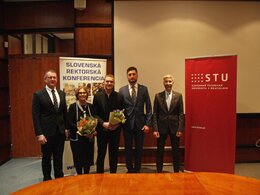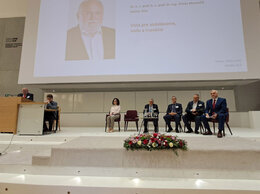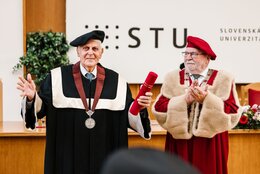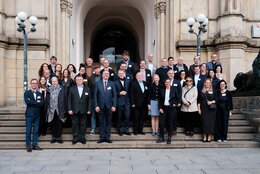doc. Ing. arch. Alexander Schleicher, PhD.
alexander.schleicher@stuba.sk
Ing. arch. Simona Kolimárová
simona.kolimarova@stuba.sk
Fakulta architektúry a dizajnu STU
Námestie slobody 19
812 45 Bratislava 1
Abstract:
The catalogue of artworks features a number of projects dealing with the historical area of the former barracks on Martinský vrch (Martinský Hill) below Zobor in Nitra. The area of the former barracks is a place that is currently not an integral part of the structure of the city's public spaces, despite its proximity to the city centre. The work goes from the urban scale of the entire site to the design of reconstructions of historical buildings to new buildings that would complement the site and its urban structure.
In terms of scale, the largest project demonstrates the proposed urban changes in the area, the connections to the city, and the addition of a new urban structure that would be in accordance with the current city structure, while respecting the greenery and the leisure and recreational function of the park. The project presents its historical and contemporary functional factors that have determined its creation. The individual architectural designs present objects of administrative, cultural, creative and educational functions of local and regional significance.
In the catalogue we can find two alternatives of the location, but also of the material-spatial form of the Art Museum building (the Gallery). The first alternative is a closed solitaire orientated towards an optimal exhibition experience. The second alternative is to incorporate the central space of the barracks with the Command Building with a new structure that would link the individual objects and integrate them into a complex gallery unit.
The Šiator Museum project presents the possibility of functionally integrating smaller historical objects into an organic complex with a new building and an active public space. This creates a viable organism that not only functions on its own, but also provides a different spatial experience for visitors to the site.
Further projects in the catalogue are the Archaeopark project and the Museum of Great Moravia project, which are situated in one location and thus present a functional alternative on site. Together, they present the possibilities of building a museum that presents the history of the site in connection with an in-situ exhibition of various excavations and archaeological discoveries.
The two alternatives of the Museum of Great Moravia and the Archaeological Museum demonstrate functional but also spatial and material alternatives of the buildings in relation to the archaeological excavations, as well as the newly proposed location of the administrative facilities of the archaeological institute.
The Artotheque project is a new construction within the strict structure of the historic barracks buildings. The Artotheque building in the catalogue shows a new object typology not yet realised in Slovakia and its possible architectural form.
The Coworking building presented in the catalogue meets the current requirements for administrative space and, at the same time, respects the existing urban structure and its grid. The response to the surrounding character can also be seen in the unambiguous facade.
In the catalogue you can find two projects of the Library - the authors designed the building on different plots and with a different approach. While in one project, we can see a distinctive solitaire, the second object is composed of several interconnected structures, creating a permeable library monoblock.
The project of the Institute of Archaeology of the Slovak Academy of Sciences is presented in the catalogue in three variants. The buildings are situated on the same site, but the individual authors approach the design of the administrative and research centre differently and create alternative experiences of the surrounding public space.
The presented catalogue demonstrates valuable visions for the development of a so far neglected area that has the potential to become one of the organic sustainable parts of the city.
DOI: 10.61544/FCIG5500![]()
Literatúra:
[1] O Nitre, Dostupné na internete: https://www.nitra.eu/8538/o-nitre
[2] SAN-HUMA’90 s.r.o. (2012) Urbanistická štúdia Areál Kasární pod Zoborom v Nitre. str. 10 Dostupné na internete: https://nitra.sk/wp-content/uploads/2022/06/Urbanisticka-studia-Areal-Kasarni-pod-Zoborom-v-Nitre-textova-cast-2.pdf
[3] SAN-HUMA’90 s.r.o. (2012) Urbanistická štúdia Areál Kasární pod Zoborom v Nitre. str. 10 Dostupné na internete: https://nitra.sk/wp-content/uploads/2022/06/Urbanisticka-studia-Areal-Kasarni-pod-Zoborom-v-Nitre-textova-cast-2.pdf
[4] SAN-HUMA’90 s.r.o. (2012) Urbanistická štúdia Areál Kasární pod Zoborom v Nitre. str. 11 Dostupné na internete: https://nitra.sk/wp-content/uploads/2022/06/Urbanisticka-studia-Areal-Kasarni-pod-Zoborom-v-Nitre-textova-cast-2.pdf
[5] KRAJSKÝ PAMIATKOVÝ ÚRAD V NITRE (2010) Návrh na vyhlásenie za národnú kultúrnu pamiatku. Kasáreň býv. „Šiator tábor“ Nitra. str. 10
[6] OROSOVÁ M., ŽAŽOVÁ H. (2017) Bastiónové pevnosti a košická citadela. In Vojenská história. Bratislava: Vojenský historický ústav, 2017, str. 7
[7] OROSOVÁ M., ŽAŽOVÁ H. (2017) Bastiónové pevnosti a košická citadela. In Vojenská história. Bratislava: Vojenský historický ústav, 2017, str. 8
[8] OROSOVÁ M., ŽAŽOVÁ H. (2017) Bastiónové pevnosti a košická citadela. In Vojenská história. Bratislava: Vojenský historický ústav, 2017, str. 30
[9] DANGL, Vojtech: Bratislava ako posádkové mesto (1867 – 1914). In: Vojenská história 2013, č. 2, s. 6– 31.
[10] PASTOREKOVÁ, L. (2015) Kasárne ako dôležitý aktér rozvoja našich miest. str. 33 Dostupné na internete: https://alfa.stuba.sk/wp-content/uploads/2020/05/2_2015_4_Pastorekova%CC%81.pdf
[11] PASTOREKOVÁ, L. (2015) Kasárne ako dôležitý aktér rozvoja našich miest. str. 33 Dostupné na internete: https://alfa.stuba.sk/wp-content/uploads/2020/05/2_2015_4_Pastorekova%CC%81.pdf
[12] PASTOREKOVÁ, L. (2015) Kasárne ako dôležitý aktér rozvoja našich miest. str. 35 Dostupné na internete: https://alfa.stuba.sk/wp-content/uploads/2020/05/2_2015_4_Pastorekova%CC%81.pdf
[13] PASTOREKOVÁ, L. (2015) Kasárne ako dôležitý aktér rozvoja našich miest. str. 38 Dostupné na internete: https://alfa.stuba.sk/wp-content/uploads/2020/05/2_2015_4_Pastorekova%CC%81.pdf
[14] PASTOREKOVÁ, L. (2015) Kasárne ako dôležitý aktér rozvoja našich miest. str. 38 Dostupné na internete: https://alfa.stuba.sk/wp-content/uploads/2020/05/2_2015_4_Pastorekova%CC%81.pdf
[15] TASR (2005) Chronológia vývoja vojenskej služby. Dostupné na internete: https://domov.sme.sk/c/2520991/chronologia-vyvoja-priebehu-vojenskej-sluzby.html
[16] TASR (2022) K nedeľňajšiemu 30. výročiu vzniku Armády SR tvorí profesionálne OS SR takmer 15.000 vojenských profesionálov. Dostupné na internete: https://www.teraz.sk/30-vyrocie-osamostatnenia-sr/ozbrojene-sily-si-1-januara-pripomen/684343-clanok.html
[17] PASTOREKOVÁ, L. (2015) Kasárne ako dôležitý aktér rozvoja našich miest. str. 38 Dostupné na internete: https://alfa.stuba.sk/wpcontent/uploads/2020/05/2_2015_4_Pastorekova%CC%81.pdf
[18] TASR (2005) Povinná vojenská služba v SR sa končí. Dostupné na internete: https://spravy.pravda.sk/domace/clanok/149447-povinna-vojenska-sluzba-v-sr-sa-konci/
[19] PASTOREKOVÁ, L. (2015) Kasárne ako dôležitý aktér rozvoja našich miest. str. 32 Dostupné na internete: https://alfa.stuba.sk/wp-content/uploads/2020/05/2_2015_4_Pastorekova%CC%81.pdf
[20] MICHAL (2020) Z dejín vojenskej služby - Časť prvá: Ako sa to všetko začalo. Dostupné na internete: https://www.cassovia.sk/sk/z-dejin-vojenskej-sluzby-cast-prva-ako-sa-vsetko-zacalo
[21] PASTOREKOVÁ, L. (2015) Kasárne ako dôležitý aktér rozvoja našich miest. str. 33 Dostupné na internete: https://alfa.stuba.sk/wp-content/uploads/2020/05/2_2015_4_Pastorekova%CC%81.pdf
[22] Dostupné na internete: https://pevnost.komarno.eu/en/about-the-tour/
[23] SAN-HUMA’90 s.r.o. (2012) Urbanistická štúdia Areál Kasární pod Zoborom v Nitre. str. 11 Dostupné na internete: https://nitra.sk/wp-content/uploads/2022/06/Urbanisticka-studia-Areal-Kasarni-pod-Zoborom-v-Nitre-textova-cast-2.pdf






![Nové číslo časopisu SPEKTRUM 1-2 [2024/2025]](https://www.stuba.sk/buxus/images/cache/stu.aktualita2/stu/informacie_o/diani_na_stu/spektrum/2024--2025/01-02_obalka.jpg)


